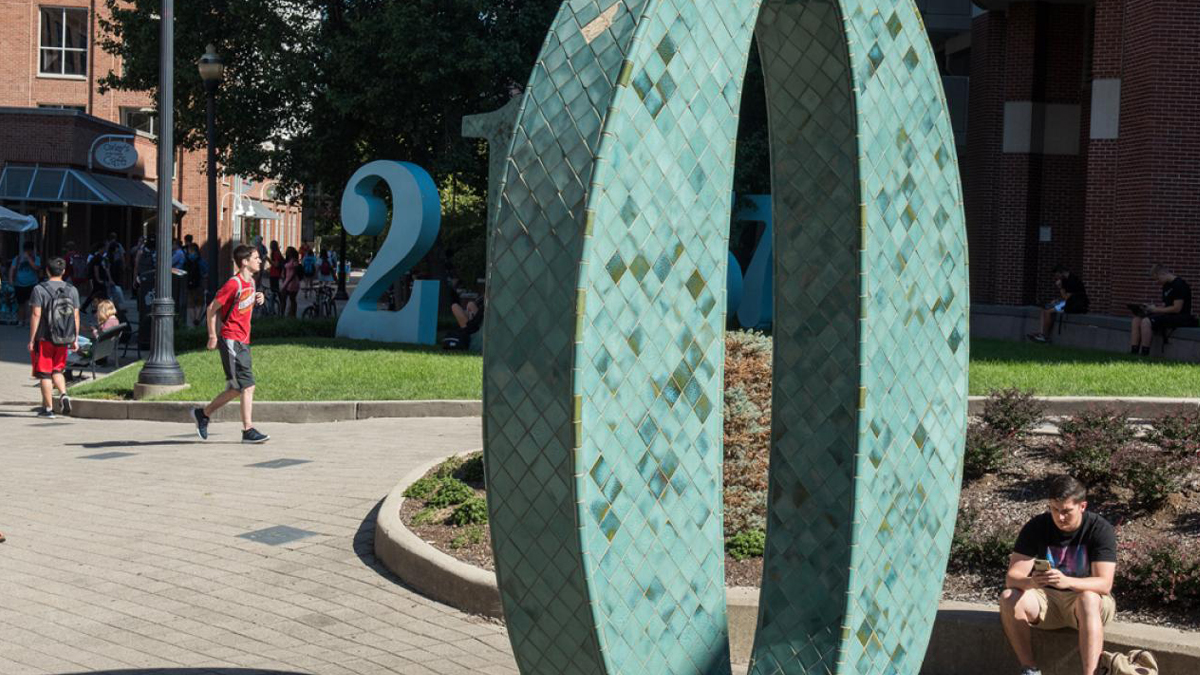The beauty of public art? You can’t avoid it
Studies show the average viewer spends about 30 seconds in front of an artwork in a gallery or museum setting.

Studies show the average viewer spends about 30 seconds in front of an artwork in a gallery or museum setting.
Now consider a piece of public art installed in a high-traffic area, such as Roy Lichtenstein’s Modern Head, erected this summer near Smith and McPherson Laboratories. The average viewer may pass the 31-foot-tall piece several times a week, and will experience it at different times of day — on cloudy and sunny days, in the summer and in the winter.
Whether they love it or hate it, they’re engaging with it.
And that’s the point of public art, says Jody Patterson, the newly named Roy Lichtenstein Foundation Endowed Chair of Art History.
“Without even realizing it, going by you’ll experience the piece in different ways and in different contexts,” says Patterson, an art historian with an expertise in public art. “Because it’s outdoors and it’s in a public space, it allows people to shift and change their opinion. You can form a relationship with it, get to know it. Your response can develop over time. It encourages critical judgment and interpretation in a way that a single visit to a museum doesn’t allow.”
Patterson’s book Modernism for the Masses: Painters, Politics and Public Murals in 1930s New York will be published by Yale University Press this fall. Her book covers the Works Progress Administration’s federal mural projects, some of the earliest federally funded public artworks in the United States.
Public art can encompass murals, sculptures, memorials and even the moldings and reliefs found in architecture. In Columbus, existing civic mural programs are part of what drew Patterson to the chair of art history position, she says. She has previously written about the American Gothic mural in the Short North, among other local pieces.
Modern Head is a gift from the Roy Lichtenstein Foundation in memory of Lichtenstein, one of Ohio State’s most famous alumni. After earning BFA and MFA degrees at the university, he went on to become one of the most influential artists in the 1960s Pop Art movement. Additionally, the foundation recently donated $6 million to fund the creation of two endowed chair positions in the departments of Art and History of Art.
Public art is about taking art out of the galleries and private collections and making it accessible to all, Patterson says. The question of who owns art and who has access to it is central to public art. Patterson believes art should be an integral part of daily experience, “not something that’s cloistered off in a sphere unto itself.”
Over time, public art becomes an important part of the viewer’s visual environment. As a three-dimensional object, it exists in both space and time. It shifts and takes on a life of its own in relationship to the viewer.
In this way, public art invites a participatory response, Patterson says. Having a one-on-one experience with monumental modern art will feel unfamiliar to most people at first, but its very nature affords the opportunity to become familiar with the piece and to form an opinion. An important aspect of public art, Patterson says, is that there are no rules and no regulations on how you engage with it.
Modern art often poses a challenge for viewers, she says, and that’s because most people don’t have the opportunity to engage with it. A sculpture by an esteemed and influential artist on campus will reach thousands of people, many of whom likely wouldn’t go to a museum and view it.
“It’s meeting people in their own environment rather than asking people to visit a museum or gallery, where they might not feel welcome or it wouldn’t be a part of their normal experience,” Patterson says. “It can be a source of inspiration, aesthetic pleasure, curiosity and so much more.”